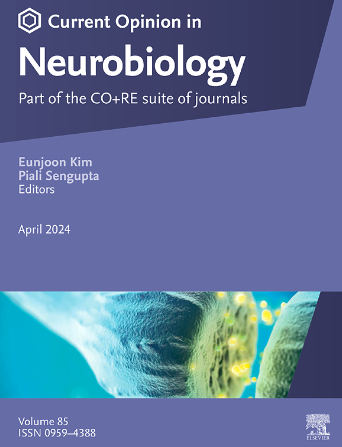标记和追踪大脑中活跃神经元编码的尖端方法
IF 5.2
2区 医学
Q1 NEUROSCIENCES
引用次数: 0
摘要
解码学习和行为背后的神经基质是神经科学的一个基本目标。随着分子技术的最新进展,在分子、细胞和电路水平上识别“关键参与者”已经成为可能,这些技术提供了高时空分辨率。即时早期基因是神经活动和可塑性的有效标记,允许识别参与基于记忆的行为的活跃细胞。钙依赖性标记系统与光或生化接近标记相结合,可以在短时间窗口内,特别是在瞬态行为期间,对更广泛的大脑区域的活性细胞群和电路进行表征。这些系统的集成扩展了跨行为范式解决不同研究问题的能力。本文回顾了目前用于活性依赖标记的分子系统,强调了它们在识别与各种科学问题相关的特定细胞群和电路方面的应用,并进一步讨论了它们的意义,以及创新方法发展的未来方向。本文章由计算机程序翻译,如有差异,请以英文原文为准。
Cutting-edge methodologies for tagging and tracing active neuronal coding in the brain
Decoding the neural substrates that underlie learning and behavior is a fundamental goal in neuroscience. Identifying “key players” at the molecular, cellular, and circuit levels has become possible with recent advancements in molecular technologies offering high spatiotemporal resolution. Immediate-early genes are effective markers of neural activity and plasticity, allowing for the identification of active cells involved in memory-based behavior. A calcium-dependent labeling system coupled with light or biochemical proximity labeling allows characterization of active cell ensembles and circuitry across broader brain regions within short time windows, particularly during transient behaviors. The integration of these systems expands the ability to address diverse research questions across behavioral paradigms. This review examines current molecular systems for activity-dependent labeling, highlighting their applications in identifying specific cell ensembles and circuits relevant to various scientific questions and further discuss their significance, along with future directions for the development of innovative methodologies.
求助全文
通过发布文献求助,成功后即可免费获取论文全文。
去求助
来源期刊

Current Opinion in Neurobiology
医学-神经科学
CiteScore
11.10
自引率
1.80%
发文量
130
审稿时长
4-8 weeks
期刊介绍:
Current Opinion in Neurobiology publishes short annotated reviews by leading experts on recent developments in the field of neurobiology. These experts write short reviews describing recent discoveries in this field (in the past 2-5 years), as well as highlighting select individual papers of particular significance.
The journal is thus an important resource allowing researchers and educators to quickly gain an overview and rich understanding of complex and current issues in the field of Neurobiology. The journal takes a unique and valuable approach in focusing each special issue around a topic of scientific and/or societal interest, and then bringing together leading international experts studying that topic, embracing diverse methodologies and perspectives.
Journal Content: The journal consists of 6 issues per year, covering 8 recurring topics every other year in the following categories:
-Neurobiology of Disease-
Neurobiology of Behavior-
Cellular Neuroscience-
Systems Neuroscience-
Developmental Neuroscience-
Neurobiology of Learning and Plasticity-
Molecular Neuroscience-
Computational Neuroscience
 求助内容:
求助内容: 应助结果提醒方式:
应助结果提醒方式:


